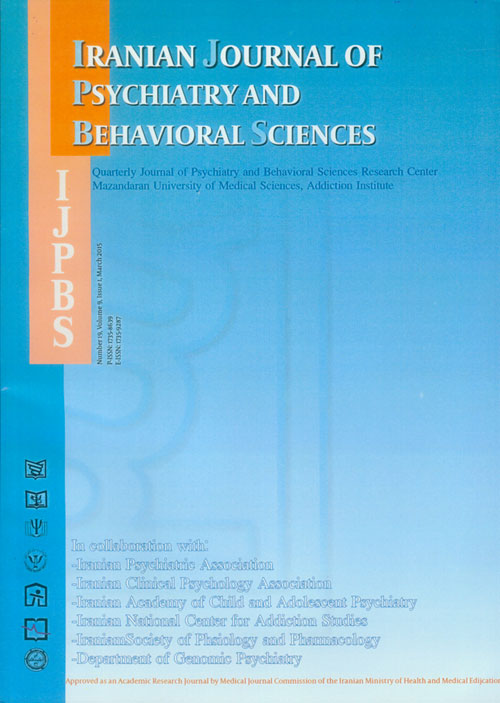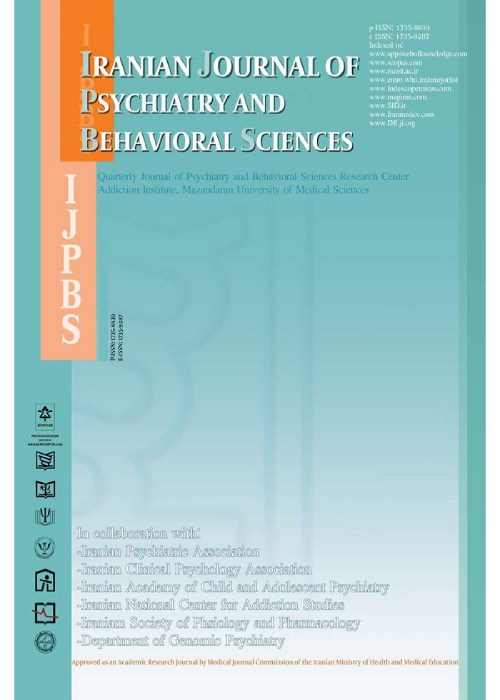فهرست مطالب

Iranian Journal of Psychiatry and Behavioral Sciences
Volume:9 Issue: 1, Mar 2015
- تاریخ انتشار: 1394/02/26
- تعداد عناوین: 9
-
-
Page 1Sexuality is a unit part of humans that has been evaluated as several fragmented particles for years. Although many biomedical and psychosocial approaches have been developed in the field of sex, these approaches usually have not been led to the complete satisfaction of the patients. It seems that for a comprehensive evaluation and management of the sexual problems, the unity of sex should be respected and the biopsychosocial multilayer aspects of the sex should be apprehended. Psychiatry is a unique point that both biomedical and psychosocial sciences reach each other. Therefore, psychiatrists should play a critical role as a modulator in the multidisciplinary team for management of the sexual problems. In this regard, comprehensive training of psychiatrists is highly recommended. One of the primary steps could be developing the psychosexual fellowship.
-
Page 4BackgroundHemodialysis as a solution for patients with chronic renal failure is a stressful process. Anxiety and depression after hemodialysis could have negative impacts on quality of life, treatment and prognosis of the disease. Some studies indicated that educating patients prior to hemodialysis could enhance patients’ quality of life and increase the likelihood of their survival.ObjectivesThis study investigated psychological impacts of psycho education on anxiety and depression symptoms in patients under dialysis. Patients andMethodsThis was a prospective, experimental intervention study with pretest and post-test. Eligible patients (n = 60) were selected randomly from dialysis center of Imam Khomeini Hospital in Sari in 2009. Hospital Anxiety Depression Scale (HADS) score of patients were eight or greater. They were divided into two matched groups. In one group, patients were given psycho education during three sessions of one-hour, while patients in the control group did not receive any education. HADS was completed for both groups before dialysis and one month after the end of educational sessions. The data were compared and analyzed using paired t-test and Chi-square test.ResultsPsycho education decreased depression score (P < 0.001) and the HADS (P = 0.008) significantly. These decreases were not significant for anxiety scores of patients (P = 0.185).ConclusionThis research indicated that psycho education based on the designed protocol decreased the scores of depression and total scores of HADS.
-
Page 9BackgroundWhile substance abuse among psychiatric patients is a widely known problem in clinical practice, there is no local study about prevalence and co-occurrence of substance abuse in north of Iran.ObjectivesThe present study was designed to determine the frequency of smoking, alcohol, opioid and cannabinoid substances, and prescription medicines abuse or dependence among Psychiatric Inpatients. Patients andMethodsA cross-sectional 2-year case register study was conducted on all (n = 492) psychiatric inpatients of Zare Psychiatric Hospital in Sari located in north of Iran. The data were obtained by using a standardized and validated questionnaire that contained demographic information along with information on co-morbid psychiatric problems and alcohol, cannabinoids, opioids, and cigarette usage.ResultsThe mean (± SD) age of samples was 39.9 (± 11.9) years and male:female ratio was 3.6. Opium with or without using other illicit substances was the most frequently abused substance (67%). Significant association were found between illicit substance abuse and demographic variables of male gender, a low level of literacy, living in the urban area, unemployment, cigarette smoking, and young age. There were statistically significant association between schizophrenia and substance abuse (P < 0.001).ConclusionHigh prevalence of dual diagnosis warrants attention to the management of substance misuse while treating mental disorders, and should be incorporated in the holistic treatment plan of psychiatric inpatients.
-
Page 13BackgroundAttention deficit hyperactivity disorder (ADHD) is a common psychiatric disorder in which impairment of executive functions plays an important role.ObjectivesThe main objective of this study was to assess the validity of the Behavior Rating Inventory of Executive Function (BRIEF) in children with ADHD. Patients andMethodsThirty children, aged 7-12 years, attending the child and adolescent clinic of Roozbeh hospital and diagnosed with ADHD according to interview with a child and adolescent psychiatrist, formed our ADHD group. In contrast, thirty participants of the control group were selected from 7 to 12 year-old students according to Conners’ Teacher/Parent Rating Scale and did not have ADHD. The kiddie schedule for affective disorders and schizophrenia-present and lifetime version-Persian version was also completed for all children to rule out other psychiatric disorders. After oral consent, parents of 60 children (ADHD = 30, control = 30), completed three questionnaires of ADHD-Rating Scale-IV, Conners’ Parent Rating Scale-Revised: Short Version and BRIEF.ResultsChildren in ADHD group got higher scores than those in the control group in all subscales and indices of BRIEF (P < 0.001). There were also good correlations between subscales and indices of BRIEF and the two other rating scales (P < 0.001).ConclusionBRIEF could be used as a valid tool to assess behavioral aspects of executive functions, especially to discriminate children with ADHD and normal ones.
-
Page 19BackgroundSubstance dependence disorder is a psychiatric disorders with different factors that influence its nature, severity, outcome, and treatment options.ObjectivesThis study evaluates the effectiveness of Acceptance-Commitment Therapy (ACT) to decrease anxiety and depression in patients with opioid dependencies who are undergoing methadone maintenance treatment (MMT).Materials And MethodsThe present study was done in Mashhad from 2011-2012. Twenty-eight patients (18-50 yr) with opioid dependency who were on MMT were selected using purposive sampling and were divided equally between case and control groups. The case group received 8 sessions of individual psychotherapy with ACT. The level of depression and anxiety of these patients were measured using the Beck Depression Inventory-II and Beck Anxiety Inventory before the initiation of ACT as a pretest, 2 weeks after the termination of ACT as the posttest, and 3-months after the termination as a follow-up. The collected data was analyzed with SPSS (ver. 20) using χ2, paired t-test, ANOVA, and MANOVA.ResultsThe pretest-posttest-follow up of anxiety showed no significant differences between the two groups (P = 0.05); however, the case group had lower depression scores in the posttest and follow-up than the control group (P = 0.04). Evaluating the results of the case group revealed that depression significantly decreased in the posttest group when compared to the pretest (P = 0.01) and there were no significant decreases in the follow up compared to the pretest (P = 0.34).ConclusionShort-term ACT for opioid dependent patients on MMT are not associated with a significant decrease in the level of anxiety; however, it is associated with a significant decrease in the level of depression. Nonetheless, this reduction was not maintained long term.
-
Page 26BackgroundSeveral cognitive domains, including attention, memory, and executive functions are impaired in bipolar disorder.ObjectivesThis study aimed to investigate two executive functions (working memory and response inhibition) in patients with bipolar I disorder during remission of the symptoms. Patients andMethodsIn this case-control design, 30 bipolar I patients (18 to 45 years old) were matched with 30 ones in the control group in terms of age, gender, and education. The patients were selected from Roozbeh Psychiatric Hospital (a hospital affiliated to Tehran University of Medical Sciences) from May to October 2013. They were evaluated and contrasted using working memory (Spatial Span and Spatial Working Memory (SSP and SWM)) and response inhibition (Stop Signal Task (SST)) tests.ResultsWe used independent t-tests for comparing and contrasting 2 groups on total and sub-scales scores of these 3 tests. In terms of SWM test there was a significant difference in between-group error between the two groups (P = 0.05); there was also a meaningful difference between the strategies used by two groups (P = 0.05). In SSP test, a significant difference appeared between averages of span length of the two groups. In the first and last item delays, there was also a clear difference, but the total error index was not noticeably different. In SST test, the direction error indicator in start-stop trials indicated a major difference, while in successful stops ratio, the case group had a lower ratio. In addition, reaction time to stop signs in bipolar group was meaningfully lower than the control group.ConclusionIn conclusion, even during remission phase, executive dysfunction is detectable at least in some areas in patients with bipolar disorder.
-
Page 34BackgroundAccording to the World Health Organization (WHO) report released in 2000, about 121 million people worldwide suffer from depression. The major depressive disorder (MDD) among multiple sclerosis (MS) patients is one of the most common mood disorders experienced during life. MS patients who simultaneously suffer from depression have reported more severe symptoms of disease and slower adaptation to new conditions, which ultimately increase the cost of treatment.ObjectivesThe aim of this study was to assess the effectiveness of progressive muscle relaxation therapy (PMRT) as an adjunctive therapy for reducing level of depression for MS patients.Materials And MethodsThis research had the randomized controlled trial design with pre and posttest. Thirty female patients based on criteria of MS and MDD disease, were selected from the MS Society of Shiraz, Iran. Beck Depression Inventory (BDI-II) was administered at pre and posttest. The participants were randomly allocated to two groups (experimental and control). Twelve sessions of PMRT using Bernstein and Borkovec’s method were held for the experimental group. Levin’s test, covariance and ANOVA with repeated measures were used for data analysis.ResultsExperimental and control groups were compared before and after treatment. Analysis of covariance showed that seven levels of depression decreased in the experimental group and analysis of repeated measure showed that 49% of the changes were related to PMRT.ConclusionAccording to the results, PMRT is effective in reducing depression. This therapy enables patients to reach relaxation quickly, and thus can cope with depression reactions effectively.
-
Page 41BackgroundIn response to high burden of opioid abuse in Iran, Ministry of Health has launched a large-scale opioid maintenance treatment program, delivered through a network of certified drug treatment centers. To promote opioid pharmacotherapies, there is an urgent need to develop and introduce evidence-based psychosocial interventions into the network. Patients andMethodsThis is a randomized clinical trial (RCT) to investigate feasibility and effectiveness of adding mindfulness-based group therapy to opioid pharmacotherapies as compared to opioid pharmacotherapies alone. The primary outcomes were treatment retention and percentage of weekly morphine, methamphetamine, and benzodiazepine negative tests.DiscussionThis is the first RCT that explores the effectiveness of mindfulness-based relapse prevention group therapy among opioid dependent clients in Iran. The feasibility of group therapy and comparison of outcomes in intervention and control groups should be discussed in the outcome article.
-
Page 45IntroductionScleroderma, or systemic sclerosis, is a chronic connective tissue disease generally classified as one of the autoimmune rheumatic diseasesCase PresentationA 58-year-old woman was informed of her scleroderma, while receiving oral prosthetic rehabilitation. Mouth opening limitation had unfortunately led to treatment interruption. The psychological load of the disease itself, along with dental treatment cessation, resulted in patient’s disappointment and social separation. Three hypnosis sessions were conducted for normalizing patient’s psychological status primarily, and for the facilitation of dental treatment, as well. The range of mouth opening changed from 3.7 to 6.2 cm, allowing for easier entrance of dental appliances into the mouth for completion of prosthetic rehabilitation. With the tooth prostheses in place, the patient gained more social confidence and started sharing her experience with other patients with the same condition.DiscussionThis case illustrates that hypnosis therapy may prove beneficial for patients with limited mouth opening secondary to scleroderma, facilitating the prosthetic rehabilitation programs for both dental specialists and patients, with a secondary important impact on the patient’s social perception of himself.


